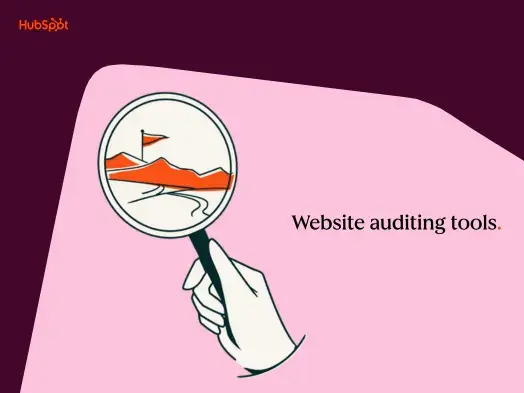What to Consider Before Buying a Website
Whether this is your first time acquiring a website or not, there are several factors to consider before making an offer. Let’s take a look at some questions you should answer before prospecting or purchasing.
1. What is the goal of this acquisition?
Before buying or even beginning to evaluate websites, you first have to determine what you’re trying to achieve with a website acquisition. Do you want increased traffic? More backlinks? A wider audience? This will help inform the types of websites you look at, your evaluation criteria, and your budget, among other factors.
For HubSpot, acquiring a website was motivated by a combination of factors. Matthew Howells-Barby, former VP of Marketing, explained, “We wanted to ultimately launch a whole new series of content that targeted a slightly different persona to what we were usually doing.”
This decision was motivated by a total addressable market (TAM) analysis of the WordPress space that HubSpot ran to decide if it was worth buying into, in terms of search volume. Braden Becker, former Senior SEO Strategist for HubSpot, said, “Once we determined there was enough volume and demand for WordPress content to scale our footprint, we started looking at websites we wanted to buy.”
2. What are your initial evaluation criteria?
There are several criteria you can use to evaluate sites that you might want to purchase. This criteria should be informed by the goals of your acquisition and the performance of your existing website. Some criteria are detailed below.
Traffic
How much traffic the website is generating, and how much it could be generating based on the keywords it targets, are vital factors to consider. Once you decide on a range of traffic and traffic potential that aligns with your goals and budget, you can eliminate any websites that fall outside of that range.
Howells-Barby explained that the website acquisition process at HubSpot kicked off with a competitive analysis of the WordPress space: “We said these are the different keywords that we'd love to rank for, and this is the kind of content that we also want to create. From there, we had a giant list of websites that we then ran through SEMrush and different tools to get an estimated amount of traffic each generated. We had a range of traffic that we accepted and eliminated options that way to get a shortlist of sites.”
Backlinks
Backlinks can be one potential input for evaluating websites to acquire, according to Becker. “You have to consider if your website would benefit from having these backlinks, which depends on the acquired site’s domain, where those links are going, how they’re distributed, and how many they have,” he said.
Tech Stack
Another input should be the tech stack the website is using and how it fits into your current tech stack. Howells-Barby explained that when they have a shortlist of websites, they look at what tech stack it’s on, whether it’s WordPress, Wix, Shopify, or something else, and what web hosting they have. “This provides a general sense of what will be the most painful to most painless migration process,” he said.
Becker emphasizes the importance of understanding the site’s tech stack. “You’ll want to ask specific questions, like what CMS is it on? What’s their analytics platform? Are there any websites or third party platforms that this site is dependent on that you would need to detach from the domain you’re purchasing?”

3. What types of websites are best to buy?
Like so many other questions on this list, the answer to this one depends on your unique business and needs.
As a general rule of thumb, Howells-Barby said, “Think about the friction to make a deal happen and how you can reduce that as much as possible.”
One way to do that is by looking at stand-alone websites instead of company’s blogs. There’s real advantages to acquiring an asset — like a stand-alone website — over a whole company, according to Howells-Barby. “You don’t have to think about onboarding employees, integrating email lists with your own (although you might want to), merging entities, changing legal officers and board of directors, and so on,” he said.
He also added that if you’re acquiring a website for the first time, start small. That way, you can get a deal done and learn all the hard lessons without spending a ton of money.
4. How is the website monetized?
In addition to evaluating a website’s traffic, understanding how it’s monetized is important for appraising its value. This is particularly important if it’s a hobby site rather than a company website.
There’s two common ways a hobby site is monetized, according to Howells-Barby. One is to monetize through ad revenue. If that’s the case, then you can use some tools to infer how much they’re making based on average ad payouts and their traffic estimation. For example, the chart below shows average CTR for native advertising across industries:

The other way a hobby site might be monetized is by generating leads or selling services via the site. “A website might only be generating a couple hundred bucks in ad revenue and affiliate links, but it might offer ebooks or courses that help a consultant make over 100K per year,” he said.
In that case, that type of website might not be the best fit for your business or budget to acquire.
5. How many authors does the website have?
It’s important to know how many authors a website has because it affects how in-depth your content review has to be.
Howells-Barby explained his team’s process when starting to evaluate a shortlist of websites: “You start with a 10,000-foot view where you look at maybe 5% of the content on a site to identify the tone is mostly aligned with your brand and there’s no red flags.”
If a site has multiple authors, however, it’s a good idea to evaluate about 5% of each of their writing, he recommends.
6. How much of the content will you actually be using?
Becker said that if you’re acquiring a site, don’t automatically assume you’ll use 100% of the content: “If doing site migration with a high volume of content on the prospective domain, you’ll want to know how much of the content you’ll plan to use 1:1 versus redirecting to your version. Aka how many pages do you want the link equity from and how many do you want to actually use the content of?”
He said answering this question will help you assess how valuable a website is and whether it’s a good fit: “For example, if you’re buying a website with 3000 pages but think you’ll probably only use 75% after auditing the site, then you can factor that into your asking price.”
7. What’s the quality of the content?
Content quality is an essential evaluation criteria. It helps determine an accurate buying price and timeline for migration.
Applying learnings from the SourceWP acquisition, HubSpot created a prospecting scorecard for rating websites based not only on its ranking and SEO components but also on the quality and other editorial components of the website.
Howells-Barby said a good question to ask when evaluating the content quality of a shortlist of websites is if you just copy and paste this content on your site, will it feel out of place? “If not and it seems to match your tone and persona, then the next layer is more intensive. You want to look at how many times they mention your competitors, what types of images are featured and are they royalty-free, if there’s any derogatory language used in the posts, if there’s a bunch of affiliate links you’d have to remove, and so on,” he said.
Once you identify any content that you wouldn’t use for these and other reasons, you can discard that traffic from the overall traffic that you’re estimating for the website.
Christina Perricone, a former Senior Manager of Content Marketing and Product, Lead & Acquisition Content at HubSpot, said another major factor that’s often overlooked is how “on brand” the acquired content is: “Do they have a similar tone and use similar language? If not, then your audience may not resonate with this messaging so you’ll have to update the content in terms of tone and style before pushing it live on your site.”
8. Who is going to update this content?
Perricone explained why this question is important to answer even before buying the website: “Usually when we're buying a site, we are doing it because we don't have any topic authority in that area and we're trying to quickly get keyword rankings and topic authority in this area. This means we probably don't have writers who have written about that topic before. So you have to consider who on your internal team might be responsible for updating this content and do they have the skill set to write this content or learn how. If not, there are alternatives that must be factored into the cost and timeline.”
For example, you could train your team in this topic area before the migration or update process or you could hire specialized freelancers to handle this content.
9. Would it make more sense to create this content in-house?
At some point before or during the evaluation process, you have to ask whether it would make more sense to create content in-house instead of acquiring it.
Howells-Barby explained, “What a website acquisition largely comes down to is the opportunity cost of getting a load of ready-made content and almost immediately starting to accrue traffic and generate conversions. Does that outweigh the ramp up period of bringing in new writers and ultimately the limitations of how much these individuals can write?”

“So what we were trying to get down to [for HubSpot’s website acquisition] is, if we look at the total traffic we estimate that we can generate by writing about a set number of topics, multiplied by how we typically convert that traffic, how much revenue would that create? Does that justify the cost of the site acquisition?”
You also have to factor in all the secondary benefits of a site acquisition, including:
- Audience
- Topic authority
- Email list
- Expert writers
For example, one reason that HubSpot decided to acquire a site was that entering this WordPress space would require them to hire technical writers, which often requires a longer hiring cycle.
10. Will this acquired content perform better on your site?
It’s important to understand the actual performance of the website you’re interested in acquiring — but that’s not the full picture. It’s possible that the acquired content could perform better on your site because you have more domain authority, a wider audience, more distribution channels, or for other reasons.
Braden emphasized this point: “Just because you’re acquiring and migrating a domain with less traffic than you expect or want doesn’t mean it won’t perform better on your domain. In HubSpot’s case, we were migrating content from a domain with less domain authority to a domain with more so we didn’t need to over index on how much existing traffic it had because we knew as long as it had keyword volume that it could feasibly rank for, we could optimize it and let it grow.”
11. Do you have any requests for the existing website owner?
If you have any requests for the existing website owner, make sure to send them before the acquisition. Because once the website is in your hands, you take over all liability and ownership of the site.
“Even later down the line, you may realize you don’t have a password to some tool you need that holds up the migration process and the previous owner’s priority will not be to answer you,” Howells-Barby said.
That’s why you should consider asking for a period of support from either the original website owner or from some of the writers. If any of them are willing to provide support for a few months, they can help answer any questions as you migrate the site or even keep producing or help update the content.
12. Which stakeholders should be involved, and when?
HubSpot recommends a combination of your SEO, acquisition, legal, blog, and web development teams be involved in the process. Having stakeholders from the SEO, acquisition, and blog teams involved from the very beginning is especially critical. They can help set accurate goals, evaluation criteria, and estimated timelines for the website acquisition and migration.
Perricone stressed how important alignment between all stakeholders is before, during, and after buying a website: “Everyone needs to know what’s going on and have a say at each stage because they can help accurately predict what will be needed in terms of the migration or review or other parts of the process.”

Howells-Barby noted that it’s important to only involve other teams when there’s at least a path to an acquisition. “Most of the exploratory stage can be handled by the acquisition team,” he said. “When you have a short list of about five websites, then it’s important to introduce other teams.”
What to Consider While Buying a Website
Once you've chosen a website to acquire, it’s important to perform your due diligence before completing the purchase. This can ensure you don’t acquire any lawsuits or liabilities along with the website. Here are some questions to consider:
13. Do their analytics back up your assessment?
When prospecting websites, it’s okay to rely on estimates of the website’s traffic and other performance metrics provided by your team and the site owner. But at this stage, it’s important to ask for access to their analytics.

This stage is called due diligence and is required to verify that the website is performing the role the site owner claims it is. It’s possible some new information will be uncovered that requires some re-negotiation.
14. How is your legal team involved?
Your legal team is deeply involved at this stage to verify that everything they’ve said is correct and there’s no liability you’ll be taking on by acquiring this website. Howells-Barby explained, “It may feel like involving your legal team is going to kill the deal and that’s okay. It's actually better that the deal is killed, then you take on any risk by acquiring a site.”
15. Do you have enough budget?
The site you’re acquiring shouldn’t be at the very top of your budget. There should be some wiggle room for added expenses.
“Think of it like the unexpected home renovations that you end up having to do after you buy the house that looked ready-made when you walked through it with those rose-tinted glasses. This is the exact thing that happens with a website,” Howells-Barby said.
He recommends adding at least 20 to 25% of the deal cost on top of it to get a more accurate idea of the total cost.
What to Consider After Buying a Website
Now that you’ve acquired a website, it’s time to migrate the content.
Becker explained that there are several factors that affect the migration process: “The size of property, the type of content (directory pages, templates, etc), how you’re using it, what standards of performance and quality are will all dictate how specific the migration process is and how much you’ll work with other teams, especially the blog or content team to align with your property.”
While the actual migration process will differ for every company, there are some common questions to consider before and during the migration process. Let’s take a look at them below.
16. What content will be updated and what will be archived?
Before beginning the actual migration process, it’s important to know what you’ll do with the content.
Becker explained that the first step the HubSpot SEO team took after buying the SourceWP website was conducting an SEO audit of its blog content as well as HubSpot’s blog content. “Our goal was to determine which pages to keep, which pages to migrate or consolidate, and which to redirect (to the Website Blog homepage or a closely related page),” he said. “To do so, we first needed to determine if there was any overlap between our content and the purchased content. If there was a keyword ranking overlap with a page on our website that would suggest the purchased page would cannibalize, then we automatically redirected the purchased page to our page. Occasionally, we would merge the two posts and then redirect. Meaning, we would basically dump any valuable content of page B into our page A and then redirect the shell of the page.”
Becker recommended marking these decisions in a spreadsheet, rather than making them in real time: “You can put all URLS of the purchased website in one column and put the action (keep, migrate/consolidate, redirect) in column B.”
17. What are the most ready-to-go pieces of content?
By starting with an SEO audit, you can also identify the most ready-to-go pieces of content from the acquired website. This will help you immediately start benefiting from the existing rankings and authority of that site, without compromising your voice or brand.
Howells-Barby explained the motivation for this phase of the migration process at HubSpot: “We wanted to identify the most ready-to-go content and the minimum amount of content we believe we needed to launch this new blog property [The Website Blog].” This helped them determine how much content needed to be updated to meet that minimum and launch the blog property.
18. What’s the traffic potential of the acquired content?
In the exploratory stage, you maybe had an estimation of how much traffic potential the sites you were evaluating had. But during the actual migration process, you can get a more exact count.
Becker explained this process in depth: “Once we decided what to do with the bulk of the acquired content that was ranking for keywords, we mapped every other post to its ideal keyword and keyword volume. Basically, we wanted to evaluate its potential for performance increases before saying we can’t do anything with this content.”
With a mission to map as much keyword volume as they could find to existing blog posts, HubSpot’s team did a site analysis of what keywords the acquired domain currently ranked for and which pages ranked for those keywords, then compared it to a list of pages that weren’t ranking for any keywords but could be. “The tricky part was to pair keywords to the blog posts that they were currently ranking for or the ones we thought they should be ranking for,” he said. “One hack we used was to look at the post’s URL slug and see if that keyword had search volume.”
He explained that ultimately, the purpose of this process was to ensure HubSpot didn’t rule out any posts that weren’t currently ranking for keywords, but could be, if updated or redirected to a page on a domain with higher domain authority.
After this process, there was still some leftover content. Becker said that if there was no search volume they could map to, then they looked at preexisting traffic: “I forget our exact benchmarks, but if a post had a lot of traffic, we most likely kept it because it indicated it had non-organic value or resonance. If it didn’t have much traffic, we either archived or redirected it to the most closely related page we had on our site to get as much equity as we could from that link and all links driving into that page. We might have redirected it to the blog homepage or to pillar page to try to get more link equity.”
“That’s the benefit of our topic cluster strategy: you don’t have to pick between a lot of link equity and no link equity. For example, if we couldn’t use an acquired blog post about the difference between .htaccess redirects and 301 redirects, then we could redirect it to the technical SEO pillar because it is marginally related.”

19. How much editing does this acquired content need?
It’s important to know how much editing the acquired content that you plan to keep actually needs. This will help you estimate how long the migration process will take. Your blog or content team should be in charge of deciding how extensive the editing process should be.
Becker stressed that the blog or content team has to be the arbiter of quality, not the SEO team: “It’s a mistake to assume that just because a post is ranking well from a traffic and keyword standpoint that it needs no quality check or editing. That’s not necessarily the case. It’s possible that you’re buying content from an industry that’s immature so it’s easy for low-quality content to rank well. So you always want to loop in people in charge of editorial review no matter what the acquired content looks like from a performance data perspective.”
This paid off for HubSpot. Since the blog team optimized this acquired content according to their editorial guidelines over time rather than simply push this content live and leave it, they were able to maximize traffic gains, as shown in the chart below.

20. How will this content be updated?
Once your team has an idea of how much editing the content will require, you’ll need to create and execute a plan for making those updates.
“There are very few cases where you’ll be able to take everything from the domain you’re purchasing and redirect it to your site in bulk by clicking a big red button,” Becker said. “The reason is the review process. You can’t redirect page A to page B until page B has been reviewed and published. So you have to make sure the redirect process works in lockstep with the review process.”
According to Becker, this review process was two-fold at HubSpot: “We started with freelancers to copy edit spelling, syntax, and general clarity in HubSpot CMS only of posts we decided to keep in some form. Then upgraded posts to internal proofing for format, tone, substance issues so that the content aligned with HubSpot’s quality standards. From there, the blog team created a cadence of which posts to publish and when.”
21. What is the cadence for updating this content?
The cadence for updating the acquired content should be based on priority, according to Becker. The question is: is it more valuable to update this acquired content or to create net new content? Likely, the answer to this question will change over time.
Perricone said, “We prioritized updating this acquired content for the first few months of the Website Blog’s launch because a lot of the content had been pushed live and was off-brand, contained broken links, and promoted outdated products. So we wanted to update it quickly for branding reasons. From there, we used existing traffic and MSV to decide which of the acquired content to update first.”
However, the SEO and blog teams knew they wanted to target and rank for more keywords in the WordPress space than SourceWP did. Since this net new content would take longer to rank than the acquired content, HubSpot had to constantly reassess its priorities and performance. “Over time, the value of net new content did slowly surpass the value of the remaining updates so we adjusted our cadence accordingly,” Perricone said.
According to her, there are a few questions you can answer to find the right cadence:
- How long is it going to take you to update the acquired content?
- How long does it take your net and content to rank and generate traffic?
- How does that look in comparison to the site that you just acquired?
Becker also noted other factors: “Deciding how many acquired posts to update and publish per week depends on monthly goals and how much search volume you wanted to capture at certain times. If you think an acquired post is going to perform super well for you, you might wait to update that until you think it’s going to perform best for you.”
22. Who is going to actually migrate the content?
While the SEO and blog team should work together to create and implement the migration strategy, developers will likely have to be in charge of the actual migration.
For HubSpot, the SEO team worked directly with the web development team to migrate the content. The SEO team grouped the acquired posts in batches once they were reviewed and updated by the blog team and put them in a spreadsheet that marked which posts would go live week 1, which would go live week 2, and so on. Once they had the published versions of a batch, they’d ship the group of redirects to the web development team. Then that team performed the specific and bulk redirects.
23. What’s the expected timeline for the migration process?
Once the questions above are answered, you should have a clearer idea of how long the migration process will take. You can then communicate that timeline to your development team, or whoever is in charge of actually migrating the content, as well as other stakeholders and members of your leadership team.
Becker warned, “Don’t promise anything to your web development team that the blog team can’t cash for you. [At HubSpot] we needed to know how much content we could edit, review, and publish per week to work with the web dev team at that same pace and also to tell leadership how much content we were going to publish and redirect per week.”
The process took place over the course of multiple months for HubSpot. It could take less, or more, time depending on the amount of content you acquire and the number of people involved in the review process, among other factors.
24. How will you track the performance of acquired content versus native content?
When acquiring a website, the involved teams must nail down the process for migrating the content and tracking the performance of it, especially if you’ll be supplementing this acquired content with native content (ie. content created in-house).
“It’s helpful to know what share of traffic the purchased content is driving for the entire property and how that share changes every month as it grows,” Becker said. “If you’re purchasing content you want to expand on and create a strategy around, the traffic share of that content on the entire property will slowly go down but hopefully the total traffic of that content will go up.”
Perricone said this tracking was most important to the SEO and Acquisition teams because they want to know whether the acquisition was worth it. So they want to know how the acquired SourceWP content specifically is contributing to HubSpot’s traffic goals and signup goals.
While those teams care about the ROI of the website acquisition specifically, other stakeholders want to understand the performance of the blog as a whole. Perricone said, “My role was not to say whether the SourceWP acquisition was good or not, but to determine if this overall topic is growing our traffic. So I want to know and report on how WordPress is doing on our site on its own. I also want to report on WordPress traffic versus total traffic.”
Here’s an example of a graph comparing WordPress traffic versus total traffic for two months:

25. How will you communicate progress to other stakeholders?
A website acquisition will involve many stakeholders, and they’ll want to be updated throughout the process. This is especially important as the content is migrated and pushed live on the company’s website.
Perricone said it was important to communicate what their resource limitations were and how they were combating them throughout the migration. “But the focus was on the opportunity we had, not our blockers. So the messaging would basically boil down to, ‘These are our resources and writers’ bandwidths, this is what we can do with what we have, this is what we can expect as the outcome from what we have, and this is the plan for reaching our goals,’” she explained.
For example, in one email to stakeholders, Perricone explained that her team’s ability to capture MSV was based on resourcing, or how many posts they can produce, and mentioned several ways she was addressing that limiting factor, including:
- Prioritizing high-MSV keywords to maximize impact
- Hiring a new writer
- Regularly meeting with members of the SEO team to ensure alignment
Ready to buy a website?
Now that we’ve covered what factors to consider before, during, and after buying a website, hopefully you feel more ready to acquire a website. Answering the questions above can help ensure you avoid some challenges that HubSpot faced — as well as reap the benefits that we did — in our own website acquisition for the Website Blog.
Website Development





![How to make a website with user accounts and profiles [with WordPress, Wix, and more]](https://53.fs1.hubspotusercontent-na1.net/hubfs/53/%5BUse%20(3).webp)
![How to build a Google Site that looks good and drives business [templates & examples]](https://53.fs1.hubspotusercontent-na1.net/hubfs/53/Website%20Redesign%20Terms.png)





